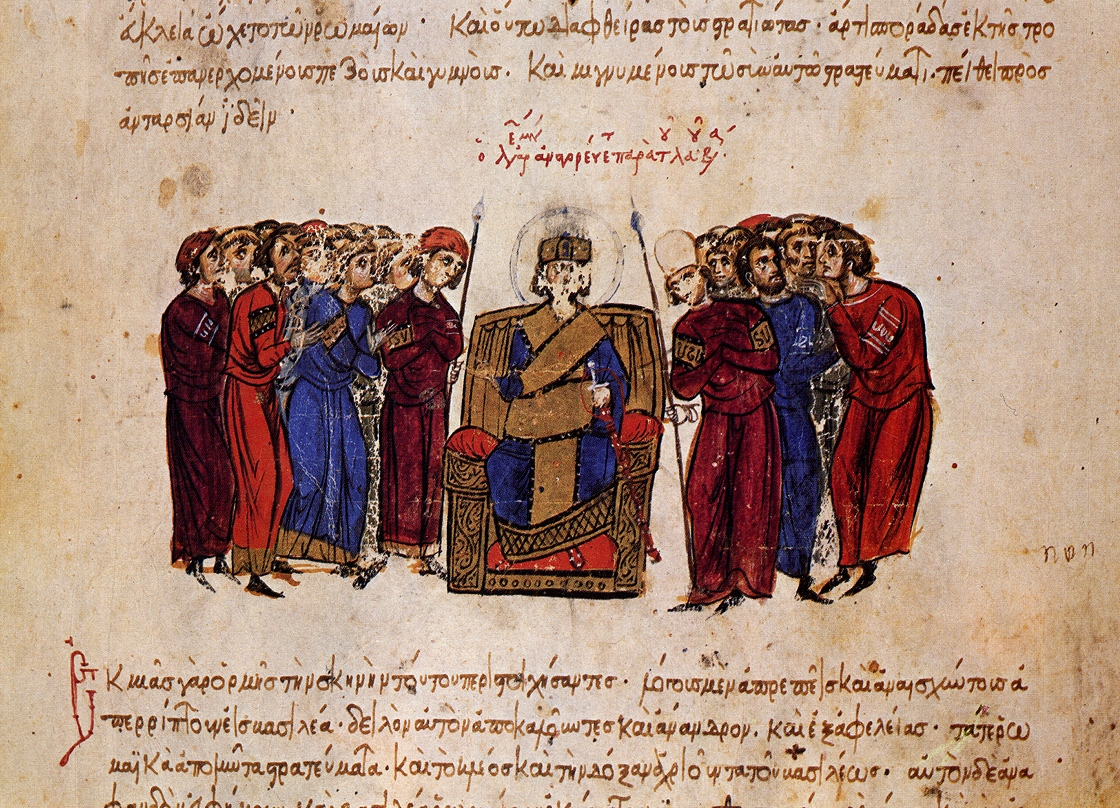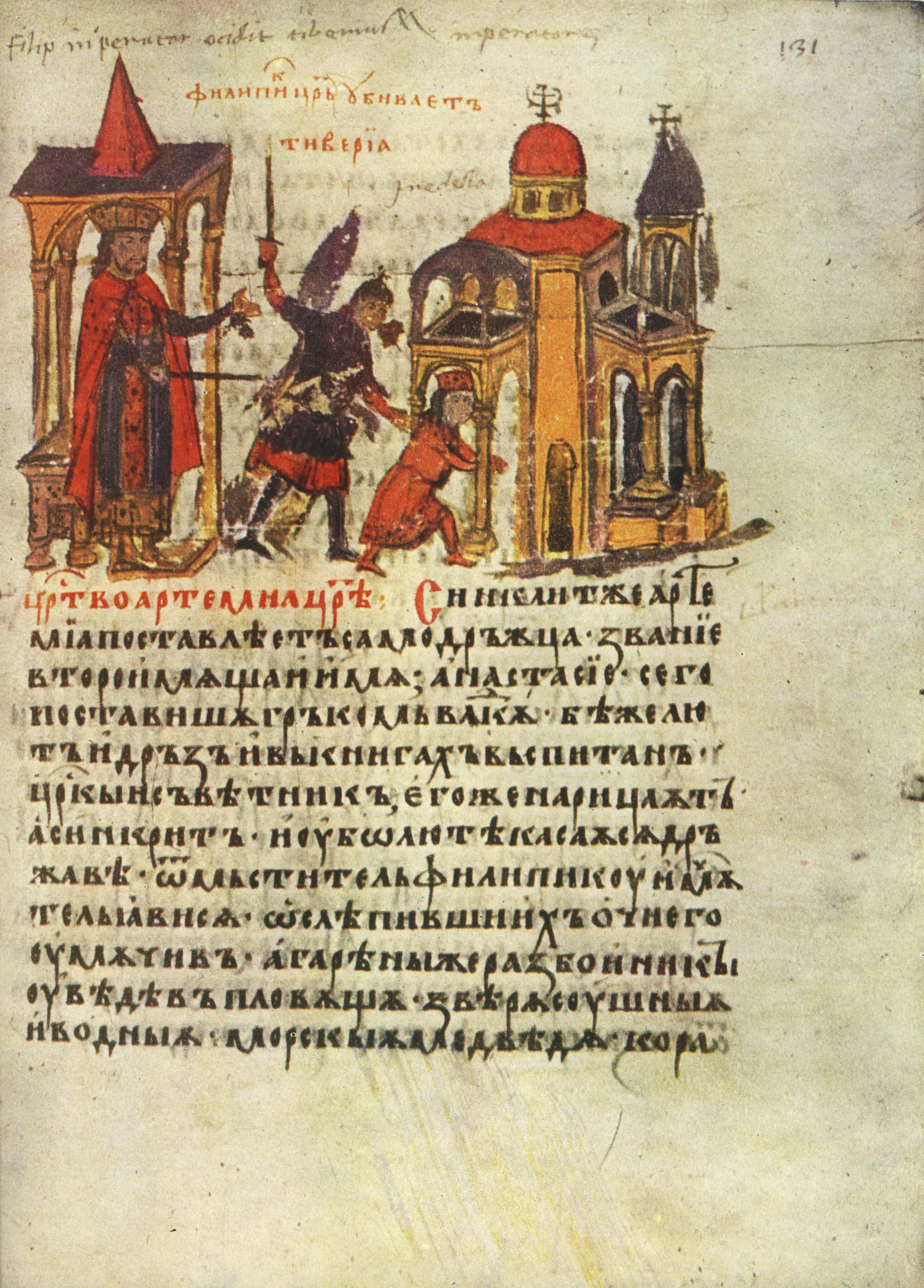|
Byzantine Armenia
Byzantine Armenia, sometimes known as Western Armenia, is the name given to the parts of Kingdom of Armenia that became part of the Byzantine Empire. The size of the territory varied over time, depending on the degree of control the Byzantines had over Armenia. The Byzantine and Sassanid Empires divided Armenia in 387 and in 428. Western Armenia fell under Byzantine rule, and Eastern Armenia fell under Sassanid control. Even after the establishment of the Bagratid Armenian Kingdom, parts of historic Armenia and Armenian-inhabited areas were still under Byzantine rule. The Armenians had no representation in the Ecumenical Council of Chalcedon in 451 because of their struggle against the Sassanids in an armed rebellion. That reason caused a theological drift to appear between Armenian and Byzantine Christianity. Regardless, many Armenians became successful in the Byzantine Empire. Numerous Byzantine emperors were either ethnically Armenian, half-Armenian, part-Armenian or p ... [...More Info...] [...Related Items...] OR: [Wikipedia] [Google] [Baidu] |
Marzpanate Armenia
Sasanian Armenia, also known as Persian Armenia and Persarmenia ( – ''Parskahayastan''), may either refer to the periods in which Armenia ( – ''Armin'') was under the suzerainty of the Sasanian Empire or specifically to the parts of Armenia under its control such as after the partition of 387 when parts of western Armenia were incorporated into the Eastern Roman Empire while the rest of Armenia came under Sasanian suzerainty but maintained its existing kingdom until 428. In 428, Armenian nobles petitioned Bahram V to depose Artaxias IV (r. 422);''Introduction to Christian Caucasian History:II: States and Dynasties of the Formative Period'', Cyril Toumanoff, Traditio, Vol. 17, 1961, Fordham University, 6. Bahram V (r. 420–438) abolished the Kingdom of Armenia and appointed Veh Mihr Shapur as ''marzban'' (governor of a frontier province, "margrave") of the country, which marked the start of a new era known as the Marzpanate period ( – ''Marzpanakan Hayastan''), a perio ... [...More Info...] [...Related Items...] OR: [Wikipedia] [Google] [Baidu] |
Leo V The Armenian
Leo V the Armenian (, ''Léōn ho Arménios''; 775 – 25 December 820) was the Byzantine emperor from 813 to 820. He is chiefly remembered for ending the decade-long war with the First Bulgarian Empire, Bulgars, as well as initiating the second period of Byzantine iconoclasm. A senior general of Armenian origin, Leo distinguished himself under Nikephoros I and Michael I Rhangabe, eventually becoming the ''strategos, stratēgos'' of the Anatolic Theme. Taking advantage of Michael's defeat at the Battle of Versinikia, he forced the emperor to abdicate in his favour. He was able to withhold the Siege of Constantinople (813), blockade of Constantinople by Krum, Krum of Bulgaria and, after Krum's death, concluded a Byzantine–Bulgarian treaty of 815, 30-year peace with his successor Omurtag of Bulgaria, Omurtag. In 815, Leo deposed Patriarch Nikephoros I of Constantinople, Nikephoros and reinstituted iconoclasm. He was assassinated by supporters of Michael II, Michael the Amorian, ... [...More Info...] [...Related Items...] OR: [Wikipedia] [Google] [Baidu] |
Philippikos Bardanes
Philippicus (; ), born Bardanes (; ) was Byzantine emperor from 711 to 713. He took power in a coup against the unpopular emperor Justinian II, and was deposed in a similarly violent manner nineteen months later. During his brief reign, Philippicus supported monothelitism in Byzantine theological disputes, and saw conflict with the First Bulgarian Empire and the Umayyad Caliphate. Biography Philippicus was originally named Bardanes (; ); he was the son of the patrician Nicephorus, who was of Armenian extraction from an Armenian colony in Pergamum. The Armenian background of Philippicus has been supported by Byzantinist historians Peter Charanis and Nicholas Adontz, and disputed by Anthony Kaldellis. Kaldellis adds that Bardanes was probably born and raised in the Byzantine realm, as his father Nicephorus possibly was. Contemporaneous sources attest to Bardanes' tutoring, scholarly interests, learning and eloquence, all of which were in Greek. Byzantine historians Leslie B ... [...More Info...] [...Related Items...] OR: [Wikipedia] [Google] [Baidu] |
Artabasdos
Artabasdos or Artavasdos ( or , from , , ), Latinized as Artabasdus, was a Byzantine general of Armenian descent who seized the throne from June 741 until November 743, in usurpation of the reign of Constantine V. Rise to power In about 713, Emperor Anastasius II appointed Artabasdos as governor ( ''stratēgos'') of the Armeniac Theme (Θέμα Άρμενιάκων, ''Thema Armeniakōn''), the successor of the Army of Armenia, which occupied the old areas of the Pontus, Armenia Minor, and northern Cappadocia, with its capital at Amasea. After Anastasius' fall, Artabasdos made an agreement with his colleague Leo, the governor of the Anatolic Theme, to overthrow the new Emperor Theodosius III. This agreement was sealed with the engagement of Leo's daughter Anna to Artabasdos, and the marriage took place after Leo III ascended the throne in March 717. Artabasdos was awarded the rank of '' kouropalates'' ("master of the palace") and became commander (count, ''komēs'') of t ... [...More Info...] [...Related Items...] OR: [Wikipedia] [Google] [Baidu] |
John I Tzimiskes
John I Tzimiskes (; 925 – 10 January 976) was the senior Byzantine emperor from 969 to 976. An intuitive and successful general who married into the influential Skleros family, he strengthened and expanded the Byzantine Empire to include Thrace and Syria by warring with the Rus' under Sviatoslav I and the Fatimids respectively. Background John was born in present-day Çemişgezek in Tunceli Province. His father, son of Theophilos Kourkouas, was a scion of the Kourkouas family, a clan of Armenian origin that had established itself as one of the chief families among the Anatolian military aristocracy by the early 10th century. His mother belonging to the Phokas family of unknown ethnicity, maybe Greek-Armenian origin. Scholars have speculated that "''Tzimiskes''" was derived either from the Armenian ''Chmushkik'' (Չմշկիկ), meaning "red boot", or from an Armenian word for "short stature", as explained by Leo the Deacon. A more favorable explanation is offered ... [...More Info...] [...Related Items...] OR: [Wikipedia] [Google] [Baidu] |
Romanos I
Romanos I Lakapenos or Lekapenos (; 870 – 15 June 948), Latinisation of names, Latinized as Romanus I Lacapenus or Romanus I Lecapenus, was Byzantine emperor from 920 until his deposition in 944, serving as regent for and senior co-ruler of the young Constantine VII. Origin Romanos derived his epithet Lekapenos, now usually treated as a family name, from his birthplace of Lakape (later Laqabin (West Syriac diocese), Laqabin) between Melitene and Samosata. It is found mostly as Lakapenos in the sources, although English-language scholarship in particular prefers the form Lekapenos, in large part due to Sir Steven Runciman's 1928 study on the emperor. He was the son of a peasant with the remarkable name of Theophylact "the Unbearable" (''Theophylaktos Abaktistos'' or ''Abastaktos''), who had rescued the Emperor Basil I from the enemy in battle at Tephrike in 872, saving his life, and had been rewarded by a place in the Imperial Guard and received estates as a reward.} Theophyla ... [...More Info...] [...Related Items...] OR: [Wikipedia] [Google] [Baidu] |
Greeks
Greeks or Hellenes (; , ) are an ethnic group and nation native to Greece, Greek Cypriots, Cyprus, Greeks in Albania, southern Albania, Greeks in Turkey#History, Anatolia, parts of Greeks in Italy, Italy and Egyptian Greeks, Egypt, and to a lesser extent, other countries surrounding the Eastern Mediterranean and Black Sea. They also form a significant Greek diaspora, diaspora (), with many Greek communities established around the world.. Greek colonies and communities have been historically established on the shores of the Mediterranean Sea and Black Sea, but the Greek people themselves have always been centered on the Aegean Sea, Aegean and Ionian Sea, Ionian seas, where the Greek language has been spoken since the Bronze Age.. Until the early 20th century, Greeks were distributed between the Greek peninsula, the western coast of Asia Minor, the Black Sea coast, Cappadocia in central Anatolia, Egypt, the Balkans, Cyprus, and Constantinople. Many of these regions coincided to ... [...More Info...] [...Related Items...] OR: [Wikipedia] [Google] [Baidu] |
Macedonian Dynasty
The Macedonian dynasty () Byzantine Empire under the Macedonian dynasty, ruled the Byzantine Empire from 867 to 1056, following the Byzantium under the Amorian dynasty, Amorian dynasty. During this period, the Byzantine state reached its greatest extent since the Early Muslim conquests, and the Macedonian Renaissance in letters and arts began. The dynasty was named after its founder, Basil I the Macedonian who came from the theme (Byzantine district), theme of Macedonia (theme), Macedonia. Origins The dynasty's ethnic origin is unknown, and has been a subject of debate. During Basil's reign, an elaborate genealogy was produced that purported that his ancestors were not mere peasants, as everyone believed, but descendants of the Arsacid dynasty of Armenia, Arsacid (Arshakuni) kings of Armenia, Alexander the Great and also of Constantine the Great. Some Persian writers such as Hamza al-Isfahani or Al-Tabari, called Basil a ''Saqlabi'', an ethnogeographic term that usually denoted ... [...More Info...] [...Related Items...] OR: [Wikipedia] [Google] [Baidu] |
Basil I
Basil I, nicknamed "the Macedonian" (; 811 – 29 August 886), was List of Byzantine emperors, Byzantine emperor from 867 to 886. Born to a peasant family in Macedonia (theme), Macedonia, he rose to prominence in the imperial court after gaining the favour of Emperor Michael III, whose Eudokia Ingerina, mistress he married on his emperor's orders. In 866, Michael proclaimed him co-emperor. Fearing a loss of influence, Basil orchestrated Michael's assassination the next year and installed himself as sole ruler of the empire. He was the first ruler of the Macedonian dynasty. Despite his humble origins, Basil was an effective and respected monarch. He initiated a complete overhaul of Byzantine law, an effort continued by his successor that ultimately became the ''Basilika''. On the foreign front, he achieved military success against the heretical Paulicianism, Paulicians, whom he subjugated in 872. He also pursued an active policy in the west, allying with Carolingian emperor Louis ... [...More Info...] [...Related Items...] OR: [Wikipedia] [Google] [Baidu] |
Cappadocians
The Cappadocian Greeks (; ), or simply Cappadocians, are an ethnic Greek community native to the geographical region of Cappadocia in central-eastern Anatolia; roughly the Nevşehir and Kayseri provinces and their surroundings in modern-day Turkey. There had been a continuous Greek presence in Cappadocia since antiquity, and by at least the 5th century AD the Greek language had become the lingua franca of the region. In the 11th century Seljuq Turks arriving from Central Asia conquered the region, beginning its gradual shift in language and religion. In 1923, following the mass killing of Christian Ottomans across Anatolia, the surviving Cappadocian communities were forced to leave their native homeland and resettle in Greece by the terms of the Greek–Turkish population exchange. Today their descendants can be found throughout Greece and the Greek diaspora worldwide. History Early migrations The area known as Cappadocia today was known to the Ancient Persians as ''K ... [...More Info...] [...Related Items...] OR: [Wikipedia] [Google] [Baidu] |
Heraclius
Heraclius (; 11 February 641) was Byzantine emperor from 610 to 641. His rise to power began in 608, when he and his father, Heraclius the Elder, the Exarch of Africa, led a revolt against the unpopular emperor Phocas. Heraclius's reign was marked by several military campaigns. The year Heraclius came to power, the empire was threatened on multiple frontiers. Heraclius immediately took charge of the Byzantine–Sasanian War of 602–628. The first battles of the campaign ended in defeat for the Byzantines; the Persian army fought their way to the Bosphorus but Constantinople was protected by Walls of Constantinople, impenetrable walls and a strong navy, and Heraclius was able to avoid total defeat. Soon after, he initiated reforms to rebuild and strengthen the military. Heraclius drove the Persians out of Asia Minor and pushed deep into their territory, defeating them decisively in 627 at the Battle of Nineveh (627), Battle of Nineveh. The Persian Shah Khosrow II was overthro ... [...More Info...] [...Related Items...] OR: [Wikipedia] [Google] [Baidu] |






